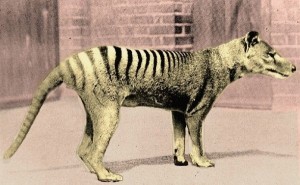The New Guinea Thylacine – Crying Wolf in Irian Jaya?
Posted by: Karl Shuker on May 8th, 2013
There have been many searches for living thylacines or Tassies in Tasmania and mainland Australia, but should cryptozoologists be seeking it in New Guinea instead?
“The official extinction in 1936 on Tasmania of the remarkable thylacine (aka Tasmanian tiger and Tasmanian wolf – Tassie for short) Thylacinus cynocephalus, that tiger-striped canine marsupial mammal as big as a wolf but which could hop like a kangaroo and had a pouch like one too, is well-documented, as is its much earlier disappearance a couple of millennia ago on the Australian mainland. Less familiar, conversely, is the fact that during the Pleistocene epoch, ending a mere 11,700 years ago, the thylacine also existed on New Guinea. Similarly, whereas the chronicles of cryptozoology are fairly bulging with unconfirmed post-1936 thylacine sightings both on Tasmania and in mainland Australia, it is not so well known that modern-day reports of suspiciously thylacine-like beasts have also emerged from New Guinea, specifically Irian Jaya (New Guinea’s less-explored western, Indonesian half), where such creatures are referred to by local people as the dobsegna.”
About Karl Shuker
My name is Dr Karl P.N. Shuker. I am a zoologist (BSc & PhD), media consultant, and the author of 25 books and hundreds of articles, specialising in cryptozoology and animal mythology. I have a BSc (Honours) degree in pure zoology from the University of Leeds (U.K.), and a PhD in zoology and comparative physiology from the University of Birmingham (U.K.).
I have acted jointly as consultant and major contributor to three multi-author volumes on cryptozoology and other mysterious phenomena.
I am the Life Sciences Consultant to The Guinness Book of Records/Guinness World Records (Guinness: London, 1997-present day), and was consultant to Monsters (Lorenz Books: London, 2001), as well as a contributor to Mysteries of the Deep (Llewellyn: St Paul, 1998), Guinness Amazing Future (Guinness: London, 1999), The Earth (Channel 4 Books: London, 2000), and Chambers Dictionary of the Unexplained (Chambers: London, 2007).
I appear regularly on television & radio, was a consultant for the Discovery TV series Into the Unknown, and a question setter for the BBC's quiz show Mastermind.
I am a Scientific Fellow of the Zoological Society of London, a Fellow of the Royal Entomological Society, a Member of the Society of Authors, and the Cryptozoology Consultant for the Centre for Fortean Zoology (CFZ).
I have written articles for numerous publications, including Fortean Times, The X Factor, Paranormal Magazine, FATE, Strange Magazine, Prediction, Beyond, Uri Geller's Encounters, Phenomena, Alien Encounters, Wild About Animals, All About Cats, All About Dogs, Cat World, etc.
In 2005, I was honoured by the naming of a new species of loriciferan invertebrate after me - Pliciloricus shukeri.











I’d say “in addition”
Ive had the same thoughts 🙂
Wasn’t there a flap of sightings on new Zealand
This is a fascinating article. Thanks for bringing it to us.
I also appreciate the scholarly approach to your work. I suspect I will be spending some time exploring your blog.
There is so much mystery still waiting to be discovered in the southeast pacific rim islands.
Well, I entered the read skeptical. But some sizable new mammals have been found in New Guinea rather recently.
I wonder what Tim Flannery (Google him; a few entries, but the right one should be obvious) has to say about this, actually. He doesn’t mention the possibility anywhere that I have read.
One thing that I hadn’t thought about is that the thylacine was well-known in Australia by European settlers as well as by the natives.
European penetration into New Guinea hasn’t been nearly so extensive. Differences in habitat – and what could be considered more diffiult interactions with the native population – could make for greater difficulty confirming an animal like this there.
It seems problematical that there are no records of speciemens. (Particularly given the native population’s extensive hunting, gathering, and taste for ornamentation using the local wildlife as a resource.) Not only, however, could the above factor account for that, but I don’t let the absence of specimens (although not without reports of same) discount the evidence for sasquatch and yeti, so I guess I can’t do that here either.
I’m with you Karl. Don’t have much confidence thylacines exist anymore, but it’s certainly a win, win location. Given the Wallace line, if there are to be any major new marsupial discoveries Irian Jaya should rank #1 on anyone’s list.
As for Tim Flannery’s thoughts, Peter Schouten once wrote me that Flannery, John Long and Mike Archer pretty much all agreed the thylacine is extinct but that none of them would go into cardiac arrest should one turn up.
Like your taste in art. Have the same Rod Scott print myself.
That same image is on the $1 2011 Tuvalu silver coin. But you knew that.
This would almost certainly be a different genus, let alone species, than the Tasmanian wolf — which is not to say it would not be worth following up on. Could there be an “undiscovered” dog-sized marsupial predator in New Guinea? I can’t see why not.
As for New Zealand, though, there are no large indigenous mammals. In fact, I think there are no indigenous mammals other than bats and pinnipeds. The only way a thylacine could have made it there is with human help, maybe as part of a zoo. Could a couple of specimens have escaped and founded a breeding population? Maybe, but not likely.
Have never heard of thylacines being seen in New Zealand.
Will say the more I think about it that camp site sighting could have been of a New Guinea singing dog and cub. Very rarely encountered. And most definitely native to Irian Jaya.
Thanks, everyone, for the kind and interesting comments – glad that, like me, you find the possible survival of the thylacine in New Guinea an intriguing possibility. It’s a shame that it doesn’t receive as much attention as accounts of putative thylacines in Tasmania and mainland Australia. I haven’t encountered any New Zealand reports, but I have additional ones for New Guinea – perhaps I should write an expanded version of this article at some point. Re the camp site sighting of an adult and cub: I think that the stiffened tail (and probably the impressive jaw gape too) discounts the New Guinea singing dog as an identity, together with the fact that, sadly, the latter canid is all but extinct on New Guinea now, so a sighting of a singing dog would be almost as exciting as one of a thylacine here. Worth noting too is that a living New Guinea thylacine might have different/reduced striping from that of Tasmanian/Australian ones, due to the long geographical (and hence genetic) separation, so the paleness of the campsite creatures does not automatically disqualify them from being thylacines. In any event, I feel that New Guinea offers the best prospect of thylacine rediscovery, so we can but hope that an expedition dedicated to thylacine-seeking visits Irian Jaya in the not too distant future. The recently-visited, hitherto-unexplored Foja Mountains there disclosed a number of notable surprises, including a giant species of rat, a minute wallaby, and a new species of honeyeater, and the black-and-white dingiso tree kangaroo is another relative newcomer from New Guinea, so there are certainly some precedents for zoological discoveries here in modern-day times.
That we seem so certain that the singing dog is close to extinction in New Guinea – and yet are so uncertain of the thylacine – simply highlights something I have said in many ways here:
We find what we look for, and (barring really good luck) we don’t find what we don’t.
Not sure that this is worth its own full-scale search, but it should be on the ‘potential’ list for any biosurveys in Oz and New Guinea.
Karl,
While Irian Jaya is certainly worthy of further thylacine investigation please allow me to play the Devil’s advocate as far as Ralf Kiesel’s anncdotal alleged early 70’s sighting goes which apparently took place under “moonlight.”
The New Guinea Singing Dog (NGSD)
Is extremely rare even to the locals and native to the highlands of New Guinea.
Wild sightings have always been of single dogs or pairs. No pack animal behavior has ever been noted in captive populations.
While the head is fairly broad and the body duly muscular, the hindquarters are lean and the medium-length tail unlike in other dogs or wolves, is seldom “wagged” even when they are excited.
The NGSD submission/play invitation is also unlike that of the dog/wolf play bow of forequarters lowered, rump high and tail wagging. The entire body is lowered to a stalking posture and an intent, staring gaze is directed toward the being solicited. Also unlike wolves or any other dogs they drop their ears forward and down, rather than folding them back against the head. They also have an “open-mouth play bite” not recorded for dogs or wolves, but seen in coyotes, in which the mouth is opened wide and later pressed over the neck or back of a “playmate.”
Having read extensively on thylacines I should also point out that I never recall ever reading any account where thylacines were attracted to the smells of human prepared food. But wolves, dogs?
Don’t believe I need to go even further, Karl. Animal behavior generally trumps human description…like the Buru!
While you might read this account and think thylacines, I read it and think New Guinea Singing Dogs.